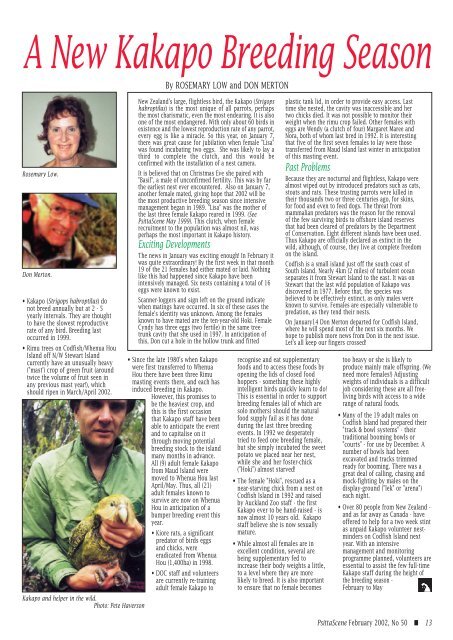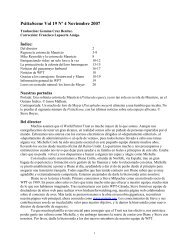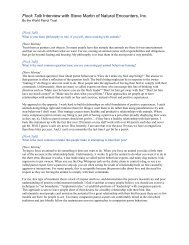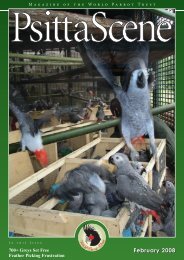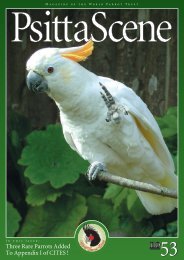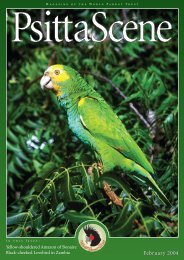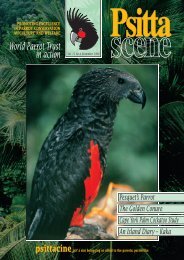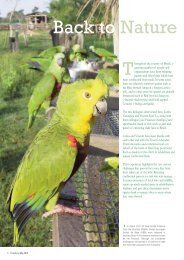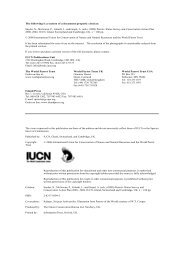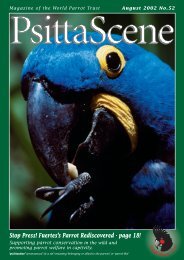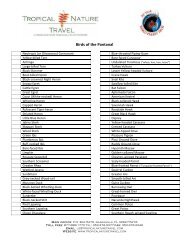Celebrating our 50th Issue! - World Parrot Trust
Celebrating our 50th Issue! - World Parrot Trust
Celebrating our 50th Issue! - World Parrot Trust
You also want an ePaper? Increase the reach of your titles
YUMPU automatically turns print PDFs into web optimized ePapers that Google loves.
A New Kakapo Breeding Season<br />
Rosemary Low.<br />
Don Merton.<br />
• Kakapo (Strigops habroptilus) do<br />
not breed annually but at 2 - 5<br />
yearly intervals. They are thought<br />
to have the slowest reproductive<br />
rate of any bird. Breeding last<br />
occurred in 1999.<br />
• Rimu trees on Codfish/Whenua Hou<br />
Island off N/W Stewart Island<br />
currently have an unusually heavy<br />
("mast') crop of green fruit (around<br />
twice the volume of fruit seen in<br />
any previous mast year!), which<br />
should ripen in March/April 2002.<br />
Kakapo and helper in the wild.<br />
Photo: Pete Haverson<br />
By ROSEMARY LOW and DON MERTON<br />
New Zealand's large, flightless bird, the Kakapo (Strigops<br />
habroptilus) is the most unique of all parrots, perhaps<br />
the most charismatic, even the most endearing. It is also<br />
one of the most endangered. With only about 60 birds in<br />
existence and the lowest reproduction rate of any parrot,<br />
every egg is like a miracle. So this year, on January 7,<br />
there was great cause for jubilation when female "Lisa"<br />
was found incubating two eggs. She was likely to lay a<br />
third to complete the clutch, and this would be<br />
confirmed with the installation of a nest camera.<br />
It is believed that on Christmas Eve she paired with<br />
"Basil", a male of unconfirmed fertility. This was by far<br />
the earliest nest ever encountered. Also on January 7,<br />
another female mated, giving hope that 2002 will be<br />
the most productive breeding season since intensive<br />
management began in 1989. "Lisa" was the mother of<br />
the last three female Kakapo reared in 1999. (See<br />
PsittaScene May 1999). This clutch, when female<br />
recruitment to the population was almost nil, was<br />
perhaps the most important in Kakapo history.<br />
Exciting Developments<br />
The news in January was exciting enough! In February it<br />
was quite extraordinary! By the first week in that month<br />
19 of the 21 females had either mated or laid. Nothing<br />
like this had happened since Kakapo have been<br />
intensively managed. Six nests containing a total of 16<br />
eggs were known to exist.<br />
Scanner-loggers and sign left on the ground indicate<br />
when matings have occurred. In six of these cases the<br />
female's identity was unknown. Among the females<br />
known to have mated are the ten-year-old Hoki. Female<br />
Cyndy has three eggs (two fertile) in the same treetrunk<br />
cavity that she used in 1997. In anticipation of<br />
this, Don cut a hole in the hollow trunk and fitted<br />
• Since the late 1980's when Kakapo<br />
were first transferred to Whenua<br />
Hou there have been three Rimu<br />
masting events there, and each has<br />
induced breeding in Kakapo.<br />
However, this promises to<br />
be the heaviest crop, and<br />
this is the first occasion<br />
that Kakapo staff have been<br />
able to anticipate the event<br />
and to capitalise on it<br />
through moving potential<br />
breeding stock to the island<br />
many months in advance.<br />
All (9) adult female Kakapo<br />
from Maud Island were<br />
moved to Whenua Hou last<br />
April/May. Thus, all (21)<br />
adult females known to<br />
survive are now on Whenua<br />
Hou in anticipation of a<br />
bumper breeding event this<br />
year.<br />
• Kiore rats, a significant<br />
predator of birds eggs<br />
and chicks, were<br />
eradicated from Whenua<br />
Hou (1,400ha) in 1998.<br />
• DOC staff and volunteers<br />
are currently re-training<br />
adult female Kakapo to<br />
• recognise and eat supplementary<br />
foods and to access these foods by<br />
opening the lids of closed food<br />
hoppers - something these highly<br />
intelligent birds quickly learn to do!<br />
This is essential in order to support<br />
breeding females (all of which are<br />
solo mothers) should the natural<br />
food supply fail as it has done<br />
during the last three breeding<br />
events. In 1992 we desperately<br />
tried to feed one breeding female,<br />
but she simply incubated the sweet<br />
potato we placed near her nest,<br />
while she and her foster-chick<br />
("Hoki") almost starved!<br />
• The female "Hoki", rescued as a<br />
near-starving chick from a nest on<br />
Codfish Island in 1992 and raised<br />
by Auckland Zoo staff - the first<br />
Kakapo ever to be hand-raised - is<br />
now almost 10 years old. Kakapo<br />
staff believe she is now sexually<br />
mature.<br />
• While almost all females are in<br />
excellent condition, several are<br />
being supplementary fed to<br />
increase their body weights a little,<br />
to a level where they are more<br />
likely to breed. It is also important<br />
to ensure that no female becomes<br />
plastic tank lid, in order to provide easy access. Last<br />
time she nested, the cavity was inaccessible and her<br />
two chicks died. It was not possible to monitor their<br />
weight when the rimu crop failed. Other females with<br />
eggs are Wendy (a clutch of f<strong>our</strong>) Margaret Maree and<br />
Nora, both of whom last bred in 1992. It is interesting<br />
that five of the first seven females to lay were those<br />
transferred from Maud Island last winter in anticipation<br />
of this masting event.<br />
Past Problems<br />
Because they are nocturnal and flightless, Kakapo were<br />
almost wiped out by introduced predators such as cats,<br />
stoats and rats. These trusting parrots were killed in<br />
their thousands two or three centuries ago, for skins,<br />
for food and even to feed dogs. The threat from<br />
mammalian predators was the reason for the removal<br />
of the few surviving birds to offshore island reserves<br />
that had been cleared of predators by the Department<br />
of Conservation. Eight different islands have been used.<br />
Thus Kakapo are officially declared as extinct in the<br />
wild, although, of c<strong>our</strong>se, they live at complete freedom<br />
on the island.<br />
Codfish is a small island just off the south coast of<br />
South Island. Nearly 4km (2 miles) of turbulent ocean<br />
separates it from Stewart Island to the east. It was on<br />
Stewart that the last wild population of Kakapo was<br />
discovered in 1977. Before that, the species was<br />
believed to be effectively extinct, as only males were<br />
known to survive. Females are especially vulnerable to<br />
predation, as they tend their nests.<br />
On January14 Don Merton departed for Codfish Island,<br />
where he will spend most of the next six months. We<br />
hope to publish more news from Don in the next issue.<br />
Let's all keep <strong>our</strong> fingers crossed!<br />
too heavy or she is likely to<br />
produce mainly male offspring. (We<br />
need more females!) Adjusting<br />
weights of individuals is a difficult<br />
job considering these are all freeliving<br />
birds with access to a wide<br />
range of natural foods.<br />
• Many of the 19 adult males on<br />
Codfish Island had prepared their<br />
"track & bowl systems" - their<br />
traditional booming bowls or<br />
"c<strong>our</strong>ts" - for use by December. A<br />
number of bowls had been<br />
excavated and tracks trimmed<br />
ready for booming. There was a<br />
great deal of calling, chasing and<br />
mock-fighting by males on the<br />
display-ground ("lek" or "arena")<br />
each night.<br />
• Over 80 people from New Zealand -<br />
and as far away as Canada - have<br />
offered to help for a two week stint<br />
as unpaid Kakapo volunteer nestminders<br />
on Codfish Island next<br />
year. With an intensive<br />
management and monitoring<br />
programme planned, volunteers are<br />
essential to assist the few full-time<br />
Kakapo staff during the height of<br />
the breeding season -<br />
February to May<br />
PsittaScene February 2002, No 50 ■ 13


